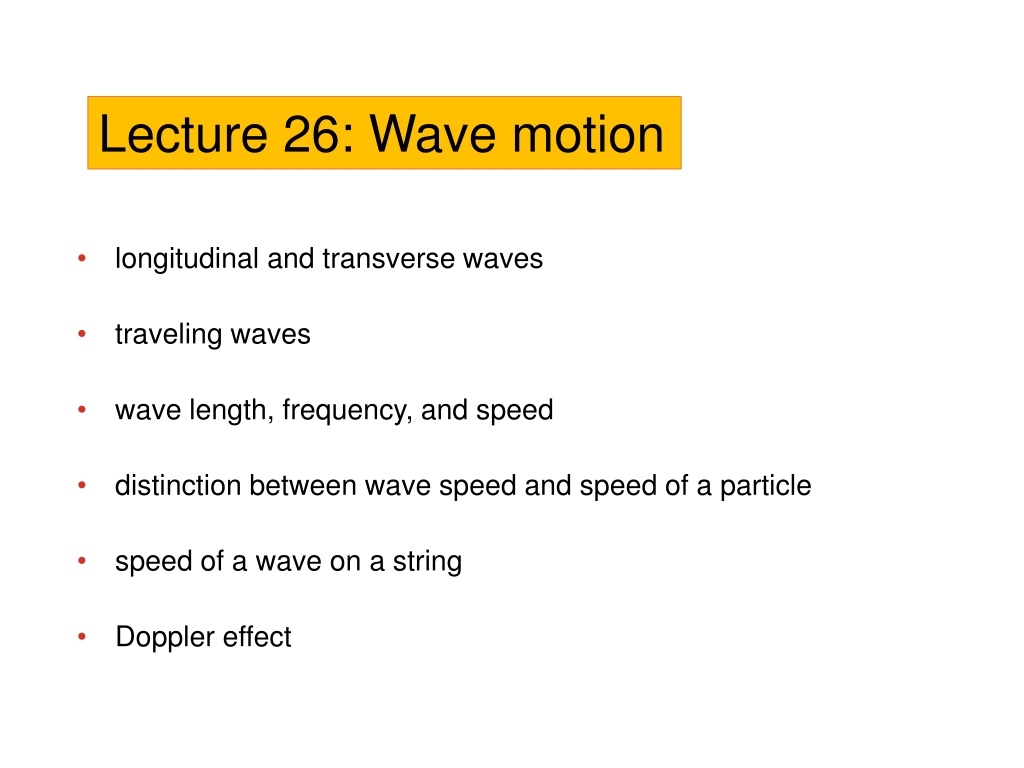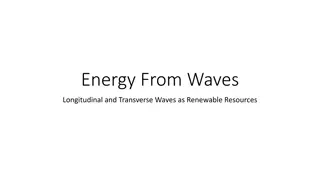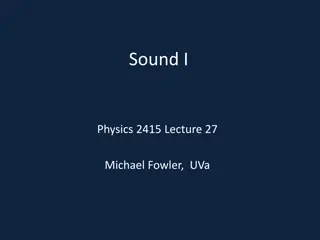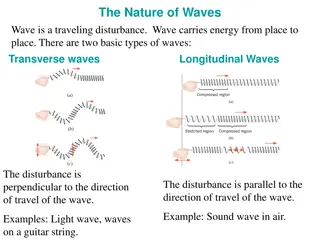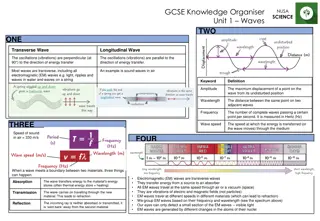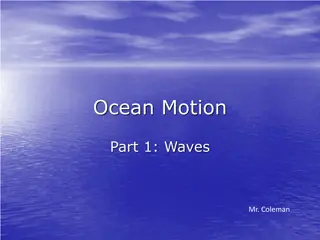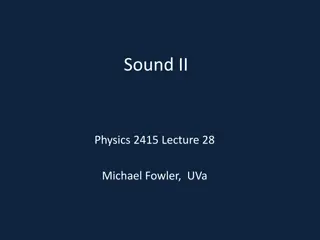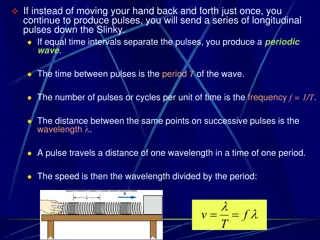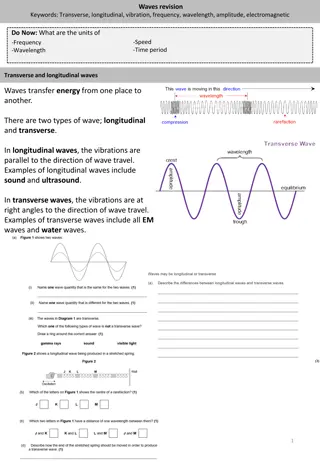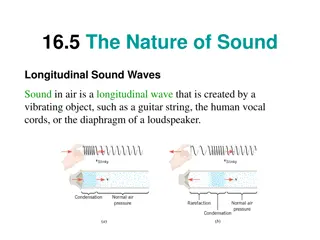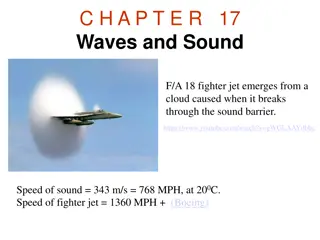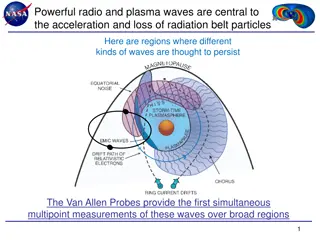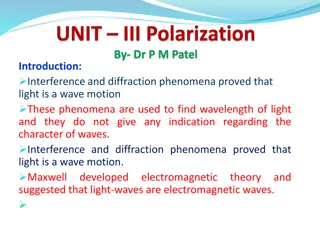Understanding Wave Motion: Longitudinal and Transverse Waves
Explore the fundamentals of wave motion including longitudinal and transverse waves, wave length, frequency, speed, and the Doppler effect. Learn about different types of waves, their characteristics, and the distinction between wave speed and the speed of a particle. Discover the properties of waves through simulations and demonstrations.
Download Presentation

Please find below an Image/Link to download the presentation.
The content on the website is provided AS IS for your information and personal use only. It may not be sold, licensed, or shared on other websites without obtaining consent from the author. Download presentation by click this link. If you encounter any issues during the download, it is possible that the publisher has removed the file from their server.
E N D
Presentation Transcript
Lecture 26: Wave motion longitudinal and transverse waves traveling waves wave length, frequency, and speed distinction between wave speed and speed of a particle speed of a wave on a string Doppler effect
The Physlet simulations presented in this lecture have been developed by, and are used with permission from, Davidson College. http://webphysics.davidson.edu/Applets/Applets.html
What is a wave? A wave is a self-propagating disturbance in a medium. The material of the medium is not moved along the wave. Particles of the medium are momentarily displaced from their equilibrium. Demonstrations
Transverse and longitudinal waves Transverse wave: displacement perpendicular to propagation direction (ex: wave on string, water wave) Longitudinal wave: displacement parallel to propagation direction (ex: sound) Simulation: http://webphysics.davidson.edu/physlet_resources/bu_semester1/c20_trans_l ong.html
Periodic waves We will only study sine-shaped waves, because all periodic functions can be expressed as a superposition of different sine functions. Simulation: Fourier Analysis- building square wave http://webphysics.davidson.edu/physlet_resources/bu_semester1/c22 _squarewave_sim.html
Sinusoidal waves Snapshot at fixed time: y A= amplitude x wave length ? wave number ? ? = ? sin(?? + )
Wave length and wave number y x ?sin ? ? + + =? sin(?? + ) ? ? + = ?(?) ? ? + + = ?? + + 2 ? = 2 ? =2
Time dependence at fixed position Particle located at x=0: ? ? = ? sin( ? + ) =2 ?= 2 ? http://webphysics.davidson.edu/physlet_resources/bu_semester1/c20 _wavelength_period.html
Traveling wave At fixed ?: ? ? = ? sin(?? + ) Wave traveling with ??: ? ?,? = ?sin ? ? ??? + ? ?,? = ?sin ?? ? + Use for ??= +? moving in positive x-dir. + for ??= ? moving in negative x-dir. = ?? = 2 ? =2 ?
Wave speed and direction ? ?,? = ?sin ?? ? + Use for ??= +? + for ??= ? (moving in positive x-direction) (moving in negative x-direction) ? = ?= ? = ? The wave travels one wavelength during one period.
? ?,? = ?sin ?? ? + Use for ??= +? + for ??= ? (moving in positive x-direction) (moving in negative x-direction)* ?? ?? ?? ?? *because ??=
Transverse velocity Velocity of a particle ?-displacement: ? ?,? = ?sin ?? ? + Caution: Particle performs harmonic motion along the ?-direction, not along the ?-direction of the wave motion need ?? For particle at fixed position ?: ??=?? ??= ? cos ?? ? + ??
Maximum transverse speed ??=?? ??= ? cos ?? ? +
Example If ?(?,?) = 3sin( 2? + 8? + ?) (in SI units), 1. What is the speed and direction of this traveling wave? Wave is moving at 4 m/s in the negative-x direction. 2. What is the maximum speed of a particle in the medium? Maximum speed of the particle is 24 m/s.
Speed of transverse wave on string ? = ?? ?= ?? Tension in the string linear mass density mass per unit length Caution: speed of a transverse wave transverse speed
Doppler Effect v v v v = Ox f f O S Sx ? = speed of the waves in the medium http://webphysics.davidson.edu/physlet_resources/bu_semester1/c21_doppler.html
Example for Doppler Effect You are exploring a planet in a very fast ground vehicle. The speed of sound in the planet's atmosphere is 250 m/s. You are driving straight toward a cliff wall at 50 m/s. In panic, you blow your emergency horn to warn the cliff wall to get out of your way. If the frequency of your horn is 1000 Hz, what is the frequency your helpless friend who is standing by the cliff wall will hear? What is the frequency of the sound you hear reflected off the cliff before you crash into it?
Beats If two waves traveling in the same direction have frequencies ?? and ??very close to one another, they will produce beats in amplitude with a frequency equal to their frequency difference: ?????= |?1 ?2| The combined sound will warble with the beat frequency. http://webphysics.davidson.edu/physlet_resources/bu_semester1/c22_beats.html Set frequency difference to large Demo: 440Hz and 441 Hz
